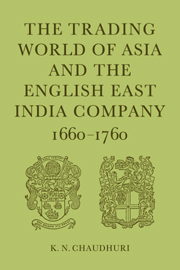Book contents
- Frontmatter
- Contents
- Tables
- Figures
- Maps
- Abbreviations
- Notes on dates, contemporaneous spellings, currency, and weights
- Preface
- Acknowledgements
- 1 The international economy and the East India trade
- 2 A formal theoretical model of the East India Company's trade
- 3 The structure of early trade and the pattern of commercial settlements in Asia
- 4 The evolution of the Company's trading system: operation and policy 1660–1760
- 5 Long-term trends and fluctuations 1660–1760
- 6 Politics of trade
- 7 Markets, merchants, and the Company
- 8 The export of treasure and the monetary system
- 9 The structure of country trade in Asia
- 10 Export of European commodities
- 11 The Company and the Indian textile industry
- 12 The Company's trade in textiles
- 13 Pepper
- 14 Import of bulk goods
- 15 Raw silk
- 16 Coffee
- 17 Imports from China
- 18 Financial results
- 19 Conclusion
- APPENDICES
- General glossary
- Bibliography
- Short titles cited in the reference notes
- Notes
- Index
2 - A formal theoretical model of the East India Company's trade
Published online by Cambridge University Press: 06 July 2010
- Frontmatter
- Contents
- Tables
- Figures
- Maps
- Abbreviations
- Notes on dates, contemporaneous spellings, currency, and weights
- Preface
- Acknowledgements
- 1 The international economy and the East India trade
- 2 A formal theoretical model of the East India Company's trade
- 3 The structure of early trade and the pattern of commercial settlements in Asia
- 4 The evolution of the Company's trading system: operation and policy 1660–1760
- 5 Long-term trends and fluctuations 1660–1760
- 6 Politics of trade
- 7 Markets, merchants, and the Company
- 8 The export of treasure and the monetary system
- 9 The structure of country trade in Asia
- 10 Export of European commodities
- 11 The Company and the Indian textile industry
- 12 The Company's trade in textiles
- 13 Pepper
- 14 Import of bulk goods
- 15 Raw silk
- 16 Coffee
- 17 Imports from China
- 18 Financial results
- 19 Conclusion
- APPENDICES
- General glossary
- Bibliography
- Short titles cited in the reference notes
- Notes
- Index
Summary
The economic and political environment
The contribution of the European East India Companies to the evolution of modern world trade was in many ways unique. Operating through a formal bureaucratic structure, the chartered companies of the seventeenth and eighteenth century helped to integrate the scattered and self-contained economic regions of pre-industrial trade into a well-defined pattern. Production and consumption, both in Europe and Asia, undoubtedly increased as a result of this process. It might even have led to hitherto unutilised resources being brought into fresh use. Historically, the Conquistadors and the Iberian methods of overseas expansion had created in the southern part of the American continent a formidable economic, commercial, and political empire which continued to exert a profound influence on Europe until the latter half of the eighteenth century. Indirectly, the Spanish model was of significance even to the maritime nations of Asia, for the Dutch and English East India Companies, following in the paths of the Conquistadors, created in another continent a phenomenon not known in the history of world trade since perhaps Roman times. This was what later came to be known as economic imperialism. It was a system in which the use of political power and armed force was inseparable, both doctrinally and in terms of every-day practice, from the more normal forms of commercial activities. Important as these larger forces were, working against the general background of contemporaneous economic and political environment, there was yet a third force whose significance was of no lesser magnitude.
- Type
- Chapter
- Information
- The Trading World of Asia and the English East India Company1660-1760, pp. 19 - 40Publisher: Cambridge University PressPrint publication year: 1978
- 2
- Cited by



